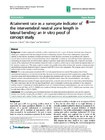Attainment rate as a surrogate indicator of the intervertebral neutral zone length in lateral bending: an in vitro proof of concept study

Abstract
Background: Lumbar segmental instability is often considered to be a cause of chronic low back pain. However, defining its measurement has been largely limited to laboratory studies. These have characterised segmental stability as the intrinsic resistance of spine specimens to initial bending moments by quantifying the dynamic neutral zone. However these measurements have been impossible to obtain in vivo without invasive procedures, preventing the assessment of intervertebral stability in patients. Quantitative fluoroscopy (QF), measures the initial velocity of the attainment of intervertebral rotational motion in patients, which may to some extent be representative of the dynamic neutral zone. This study sought to explore the possible relationship between the dynamic neutral zone and intervertebral rotational attainment rate as measured with (QF) in an in vitro preparation. The purpose was to find out if further work into this concept is worth pursuing.
Method: This study used passive recumbent QF in a multi-segmental porcine model. This assessed the intrinsic intervertebral responses to a minimal coronal plane bending moment as measured with a digital force guage. Bending moments about each intervertebral joint were calculated and correlated with the rate at which global motion was attained at each intervertebral segment in the first 10° of global motion where the intervertebral joint was rotating.
Results: Unlike previous studies of single segment specimens, a neutral zone was found to exist during lateral bending. The initial attainment rates for left and right lateral flexion were comparable to previously published in vivo values for healthy controls. Substantial and highly significant levels of correlation between initial attainment rate and neutral zone were found for left (Rho = 0.75, P = 0.0002) and combined left-right bending (Rho = 0.72, P = 0.0001) and moderate ones for right alone (Rho = 0.55, P = 0.0012).
Conclusions: This study found good correlation between the initial intervertebral attainment rate and the dynamic neutral zone, thereby opening the possibility to detect segmental instability from clinical studies. However the results must be treated with caution. Further studies with multiple specimens and adding sagittal plane motion are warranted.
Collections
Date
2015Author
Breen, Alex
Dupac, Mihai
Osborne, Neil